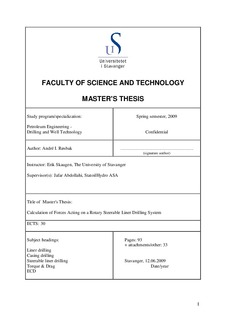| dc.description.abstract | Torque and drag calculations performed on a new liner drilling design indicate that a very
high grade drillpipe, up to S-135, is required in order to satisfy the requirements which both
axial and torsional loading place upon the system. High torque connections for the drillpipe
may also be required.
The torque values found both with simulations and manual calculations, indicate that the
proposed standard VAM TOP liner connections may not be strong enough to be used in this
well. It is therefore recommended that VAM HTF, or similar high torque liner connections,
are used in order to meet torsional loading requirements.
The use of 6 5/8” drillpipe and 5 ½” drillpipe above the top of the liner is also considered.
Based on the calculated recommended flow rates with regards to hole cleaning for the two
systems, compared with the resulting ECD values, it is suggested that 6 5/8” drillpipe
provides a better compromise between hole cleaning and ECD values. Simulations indicate
that the drillpipe connections are strong enough, while manual calculations indicate that hightorque
drillpipe connections should be considered.
The lifting force caused by the circulation of fluid is examined, but is not found to be of
significant magnitude compared to the mechanical friction. It is important to examine this
force, in order to determine whether or not the system will have problems related to buckling,
although it does not appear to present a problem in this case.
A general approach which can be used in order to determine the fatigue loading and longevity
of the liner connections is shown. However, since the actual data for the liner connections are
kept confidential by the manufacturer, no specific recommendations are made.
It should be noted that the conclusions of this thesis are valid for the wellpath and well
conditions presented in this thesis only, and that different wellpaths and well conditions may
impose other limits, either more or less stringent, on the design and use of the steerable liner
drilling system. | no_NO |
